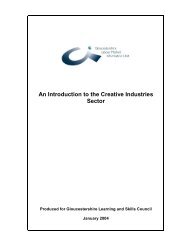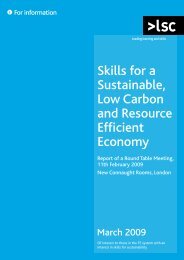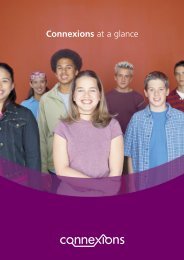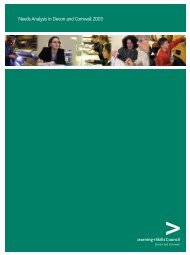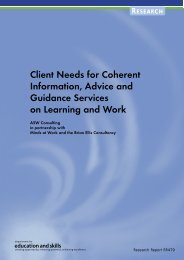Mapping the Big Green Challenge - The Skills & Learning ...
Mapping the Big Green Challenge - The Skills & Learning ...
Mapping the Big Green Challenge - The Skills & Learning ...
Create successful ePaper yourself
Turn your PDF publications into a flip-book with our unique Google optimized e-Paper software.
92 Chapter 7.4 – Low Carbon Youth SchemesCarbon reduction measuresCount of proposalsEnergy management measures (carbon regime) 12Renewable heat & micro generation, non-residential 11Lifestyle measures, waste 11Lifestyle dietary changes 10Lights & appliances, non-residential buildings 7Transport modal shift (using car less) 7Residential measures, lifestyle changes in <strong>the</strong> home 6Chart 53 – Low Carbon YouthSchemes, systemic levels,25 proposalsOrganisation40%Mixed12%Community44%Household4%<strong>The</strong>se proposals tend to have more systemic projects than <strong>the</strong>average across <strong>the</strong> whole set (64% compared with 54%). <strong>The</strong>systemic level varied, some involving only <strong>the</strong> school or youthorganisation (with a general intention that <strong>the</strong> children wouldspread <strong>the</strong> message wider), and some had a wider levelinvolving <strong>the</strong>ir surrounding community, more overtly stressing<strong>the</strong> use of <strong>the</strong> children as ambassadors. <strong>Challenge</strong>rs ofteninvoked ‘pester power’ as rationale for this approach.<strong>The</strong> emphasis is on Practice ra<strong>the</strong>r than Product, with 50%being primarily about behavioural changes, and most of <strong>the</strong>rest a mixture of product and practice (just 2 are productonly). Perhaps ironically, given <strong>the</strong> focus on education, <strong>the</strong>reis a very high proportion of only regime innovations in thisproposal type.7.4.2 <strong>Challenge</strong>r Group TypesA third of <strong>the</strong> proposals are proposed by <strong>the</strong> schools / youthgroups <strong>the</strong>mselves (‘self-initiated’) and two thirds areprojects devised by organisations aiming to work withschools. <strong>The</strong> Professionally Led (which might better be called‘externally initiated’ in this category) were primarily charities,with a mix of youth, development and energy focus, while<strong>the</strong> grassroots were mostly <strong>the</strong> schools or youth bodies<strong>the</strong>mselves or parent teachers associations (<strong>the</strong> informalgroups). <strong>The</strong> three ‘new groups’ are partnerships orexperienced individuals coming toge<strong>the</strong>r specifically for <strong>the</strong>proposed project – quite <strong>the</strong> opposite of ‘inexperienced’.Four were initiated by children <strong>the</strong>mselves.Chart 54 - Low Carbon YouthSchemes, grassroots andprofessionally led, 39 proposalsProfessionallyLed Proposals69%GrassrootsProposals31%<strong>The</strong>re is a much higher than average number of partnershipsin this section, with 25% of <strong>the</strong> applications being from external organisations working in partnershipwith schools or youth groups. All are about spreading <strong>the</strong> message through learning.Appleby Ltd July 2009



